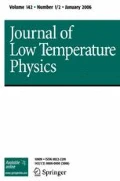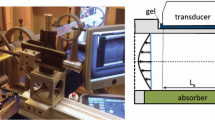Abstract
Although the suction vortex is the one of the most common vortices, its flow structure has not been fully understood. The main reasons for this are the experimental difficulty due to the very rapid flow change near the core. However, superfluid helium may help us better understand the suction vortex, because the flow in the superfluid helium can be characterized by the circulation measured by the first sound velocity, and the configuration of the quantized vortex lines can be measured with the second sound attenuation technique, as reported in our previous results (Obara et al. in Phys Rev Fluids 6:064802, 2021). In this paper, we report the effectiveness of an ultrasound circulation meter using the correlation-based differential time-of-flight method. Using this technique, the accuracy for measuring the circulation was greatly improved; we found that the circulation was proportional to the rotation speed of the turbine, which can be interpreted by considering the transport and dissipation of total angular momentum in the fluid.


Similar content being viewed by others
Notes
In Fig. 2, the scattering of the data was larger at the smallest rotation speed. We performed several measurements at smaller rotational speeds, but the TOF values showed a large variation each time. The reason for this is that at rotation speed below 4 rev./s, the liquid may not follow the motion of the turbine because of the large torque ripple of the motor.
References
J.M. Burgers, Adv. Appl. Mech. 1, 171–199 (1948)
A.H. Shapiro, Nature 196, 1080 (1962)
M. Sibulkin, J. Fluid Mech. 14, 21 (1962)
A. Andersen, T. Bohr, B. Stenum, J.J. Rasmussen, B. Lautrup, Phys. Rev. Lett. 91, 104502 (2003)
A. Andersen, T. Bohr, B. Stenum, J.J. Rasmussen, B. Lautrup, J. Fluid Mech. 556, 121 (2006)
S. Inui, T. Nakagawa, M. Tsubota, Phys. Rev. B 102, 224511 (2020)
I. Matsumura, K. Ohyama, K. Sato, K. Obara, H. Yano, O. Ishikawa, J. Low Temp. Phys. 196, 204–210 (2019)
K. Obara, I. Matsumura, N. Tajima, K. Ohyama, H. Yano, O. Ishikawa, Phys. Rev. Fluids 6, 064802 (2021)
H. Yano, K. Ohyama, K. Obara, O. Ishikawa, J. Phys. Conf. Ser. 969, 012002 (2018)
L.C. Lynnworth, Ultrasonic Measurement for Process Control (Technique, Applications (Academic Press, London, Theory, 1989)
Funding
This research was supported by the Japan Society for the Promotion of Science, KAKENHI Grants Nos. 17K18761 and 20K03865, and Osaka City University, Strategic Research Grant 2021 for top-priority research.
Author information
Authors and Affiliations
Corresponding author
Additional information
Publisher's Note
Springer Nature remains neutral with regard to jurisdictional claims in published maps and institutional affiliations.
Rights and permissions
About this article
Cite this article
Kakimoto, N., Obara, K., Yano, H. et al. Circulation of Superfluid Suction Vortex. J Low Temp Phys 208, 379–385 (2022). https://doi.org/10.1007/s10909-022-02684-1
Received:
Accepted:
Published:
Issue Date:
DOI: https://doi.org/10.1007/s10909-022-02684-1




